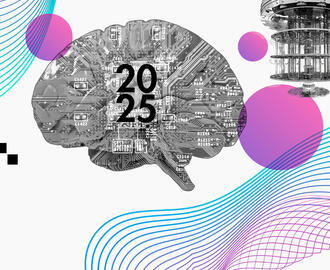Use these 3 MIT guides when implementing AI in your organization
How to use this: Draw from these MIT guides to assess your firm’s AI maturity and make decisions about which technologies to use and which skills to invest in.
Firms are making organizational changes in search of returns from their artificial intelligence implementations, with 88% of respondents to a recent McKinsey survey saying that their organization uses AI in at least one business function.
Whether your organization has already logged AI implementation successes or is just beginning to think about using the technology, these three guides derived from MIT research can help you plan for what’s next.
What’s your company’s AI maturity level?
Researchers at the MIT Center for Information Systems Research developed this AI maturity model to help firms assess their AI capabilities and chart a path forward. Using a survey of 771 companies and interviews with executives at nine firms, the researchers found that companies in the first two stages of AI maturity — experiment and prepare, and build pilots and capabilities — had financial performance below their industry’s average. Those in the latter two stages — develop AI ways of working, and become AI future-ready — had financial performance above their industry’s average.
“We recommend bringing a team of senior technical and data leaders together to assess which of the four stages your enterprise is in today, and your aspirations and time frames regarding your enterprise’s use of AI,” said Stephanie Woerner, principal research scientist at MIT CISR. “Then, discuss which enterprise capabilities and skill sets need more work. No matter where you are [with AI maturity], be bold.”
Learn more about the four stages of AI maturity in “What’s your company’s AI maturity level?”
Generative AI or machine learning: Which AI tool to use and when?
Generative AI is widely accessible and useful. Three years after ChatGPT became publicly available, and even as agentic AI starts to steal headlines, the big chatbots built on large language models can still feel novel and exciting.
That doesn’t mean generative AI is the AI for everything.
In our recent explainer on machine learning and generative AI, associate professor Swati Gupta and professor of the practice Rama Ramakrishnan break down the difference between traditional machine learning and generative AI. They explain when each is most useful and how the two are best used together. We’ve assembled their guidance into a chart you can use to guide decisions about AI use early in a project, an initiative, or strategy development.
Get more details on Gupta and Ramakrishnan’s guidance in “Machine learning and generative AI: What are they good for?”
Which human capabilities best complement AI’s shortcomings?
Firms should invest in upskilling workers and creating roles that emphasize fundamental human capabilities. MIT Sloan postdoctoral researcher Isabella Loaiza and MIT Sloan professor Roberto Rigobon grouped five human capabilities — organized under the EPOCH acronym — that they believe will be valuable as AI is deployed across industries. An analysis of U.S. Bureau of Labor Statistics data found that jobs that relied on EPOCH capabilities saw more employment growth than those that did not.
Learn more about the EPOCH framework in “These human capabilities complement AI’s shortcomings.”



